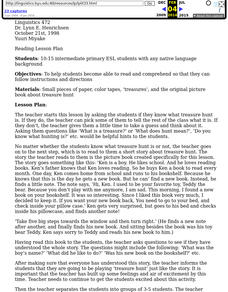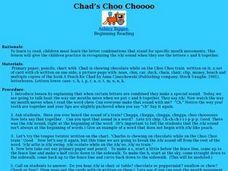Curated OER
Follow The Leader
Students participate in various games to practice life skills. In groups, students practice their powers of observation as they determine who is the chosen leader. Afterwards, they discuss the characteristics that make a leader.
Curated OER
I Scream You Scream We All Scream for Ice Cream!
Use letter boxes and example words to help kids distinguish between the sounds for short vowel e and long vowel e. They are introduced to the vowel patterns that comprise long vowel sounds, with a particular emphasis on /ea/. They...
Curated OER
The Tug Says Uhh!
Kindergarteners and first graders discover the /u/ sound! After practicing making the sound with the funny tongue twister, youngsters use their Elkonin letterboxes to divide a set of words into their phonemes. Then pairs read Bud...
Curated OER
Utah History & Geography
Fourth graders practice large digit addition. Students become familiar with column addition. Students develop knowledge of counties and county seats.
Curated OER
Hunting Through the Library
Second graders examine a library database system. They are given practical exercises to explore the database system. Finally, the student selects two books, locates the books in the library, and uses these sources for reading and research.
Curated OER
Beat the Heat
Review common digraphs with your early elementary schoolers. They identify the digraph /ea/ in written and spoken language. After a brief discussion, they apply the rule for identifying and spelling words containing the /ea/ digraph....
Curated OER
Hop on the Express Train to Read Expressively
Encourage beginning readers to read expressively. After the teacher models what it's like to read with expression, pairs of learners work together to practice developing this ability. While one learner reads, the other marks a check-list...
Curated OER
Dying to Look Good!
In this health worksheet, students examine how people have done unhealthy things to their skin in order to look fashionable. Students read about Elizabethan women putting toxins on their skin to make themselves pale. Then students read...
Curated OER
Question Words
Practice interrogative pronouns with your ESL class in this activity. Ten questions provide parts of interrogative sentences for students to complete with words like "what," "who," and "how." The worksheet would be a great class quiz or...
Curated OER
Introducing the Concept: Rates
Sixth graders explore rates as a specific type of ratio, using visual examples of unit rates and unit prices to increase comprehension. They also practice solving problems that are modeled by the instructor. The well-scripted...
Curated OER
Using Details from Nonfiction Text to Organize Sequence of Events
Is it important to do things in a certain order? Yes, especially when making a peanut butter and jelly sandwich. Or so your class will learn in a lesson on sequencing. After guided practice, class members generate their own “how-to”...
Curated OER
Guided Reading: Flora's Box
Young readers consider text-to-self connections. Learners discover the text-to-self connection as they read Flora's Box by Tina Althaide. They practice high frequency words, prepositions, and 1:1 correspondence.
Curated OER
To Kill a Mockingbird: Fun Trivia Quiz
Several questions in this interactive online quiz are formed in the "Which of these is NOT..." the answer format. In addition to assessing comprehension of Harper Lee's ubiquitous novel, it provides practice in standardized test-taking...
Curated OER
Complexity Madness
After introducing the concept and formula for finding the area of a square, try this lesson. Fifth graders will use their prior knowledge to break apart various shapes in order to determine area. This lesson includes several examples,...
Curated OER
Cause and Effect Worksheet 2
Why does Scout fear Boo? Why does George kill Lennie? Whether in literature or life, helping young learners recognize the relationship between actions and consequences is an important lesson. Have your class match twelve observable...
Shmoop
ELA.CCSS.ELA-Literacy.RI.9-10.8
Your learners need to develop skills to argue effectively, and this comes by understanding the traditions that make claims valid, and what detracts from their effectiveness. Although this resource does not give advice on how to...
Curated OER
Linguistics 472
Elementary English Language Learners practice following directions by participating in a treasure hunt. Adapt this resource to suit individual learners.
Curated OER
More or Less Pigs in the Pen
Kindergarteners practice basic addition and subtraction. In this math lesson, students sing a song about pigs on a farm to help them understand the concept of adding and subtracting things together. Some excellent extension activities...
Curated OER
Shaping the View: Composition Basics
Students are introduced to the concept of composition in visual art. They examine various compositional structures and practice identifying the focus of various pieces of art.
Curated OER
Summarization Superstars
How do you read when you know you're going to be summarizing a text? Summarize a nonfiction text with your upper elementary schoolers. Your pupils independently read a nonfiction article and write a summary paragraph using the six-step...
Curated OER
Chad's Choo Choooo
Choo, choo! Do your youngsters like trains? After studying the target sound, have your learners read A Peach for Chad. Do a class read and an independent read to increase fluency. At the lesson's close, consider creating a ch train...
Curated OER
Indians Are Coming!
Help your class increase their awareness of concepts related to reading and spelling. They identify the digraph /oa/ in spoken language and spelling. After a brief discussion, they read A Toad on the Road, listening for the target sound....
Curated OER
Orienteering - Lesson 9 - Declination
What's the difference between true north and magnetic north? Lesson 9 has your class practicing mapping using a compass and taking the correct declination into account. This lesson is one part of a 10 lesson unit on orienteering....
Curated OER
Solving Systems of Equations
Students, using algebraic operations, solve and check linear equations. At the beginning of class, they write a paragraph comparing the solving of math problems to solving real life problems. Students observe solving systems of two...























